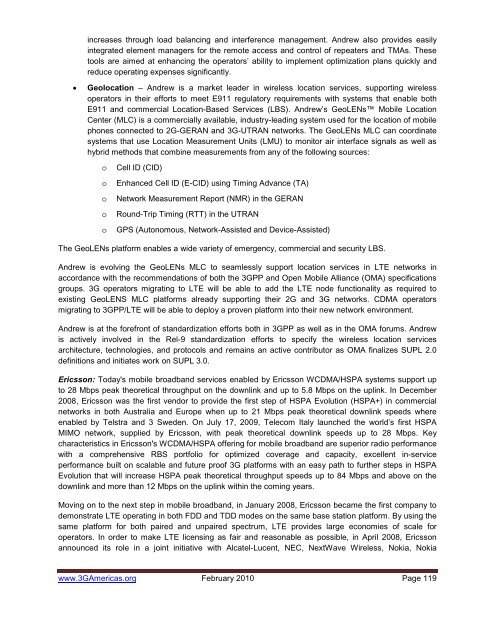UMTS: Alive and Well - 4G Americas
UMTS: Alive and Well - 4G Americas
UMTS: Alive and Well - 4G Americas
Create successful ePaper yourself
Turn your PDF publications into a flip-book with our unique Google optimized e-Paper software.
increases through load balancing <strong>and</strong> interference management. Andrew also provides easilyintegrated element managers for the remote access <strong>and</strong> control of repeaters <strong>and</strong> TMAs. Thesetools are aimed at enhancing the operators’ ability to implement optimization plans quickly <strong>and</strong>reduce operating expenses significantly.• Geolocation – Andrew is a market leader in wireless location services, supporting wirelessoperators in their efforts to meet E911 regulatory requirements with systems that enable bothE911 <strong>and</strong> commercial Location-Based Services (LBS). Andrew’s GeoLENs Mobile LocationCenter (MLC) is a commercially available, industry-leading system used for the location of mobilephones connected to 2G-GERAN <strong>and</strong> 3G-UTRAN networks. The GeoLENs MLC can coordinatesystems that use Location Measurement Units (LMU) to monitor air interface signals as well ashybrid methods that combine measurements from any of the following sources:oooooCell ID (CID)Enhanced Cell ID (E-CID) using Timing Advance (TA)Network Measurement Report (NMR) in the GERANRound-Trip Timing (RTT) in the UTRANGPS (Autonomous, Network-Assisted <strong>and</strong> Device-Assisted)The GeoLENs platform enables a wide variety of emergency, commercial <strong>and</strong> security LBS.Andrew is evolving the GeoLENs MLC to seamlessly support location services in LTE networks inaccordance with the recommendations of both the 3GPP <strong>and</strong> Open Mobile Alliance (OMA) specificationsgroups. 3G operators migrating to LTE will be able to add the LTE node functionality as required toexisting GeoLENS MLC platforms already supporting their 2G <strong>and</strong> 3G networks. CDMA operatorsmigrating to 3GPP/LTE will be able to deploy a proven platform into their new network environment.Andrew is at the forefront of st<strong>and</strong>ardization efforts both in 3GPP as well as in the OMA forums. Andrewis actively involved in the Rel-9 st<strong>and</strong>ardization efforts to specify the wireless location servicesarchitecture, technologies, <strong>and</strong> protocols <strong>and</strong> remains an active contributor as OMA finalizes SUPL 2.0definitions <strong>and</strong> initiates work on SUPL 3.0.Ericsson: Today's mobile broadb<strong>and</strong> services enabled by Ericsson WCDMA/HSPA systems support upto 28 Mbps peak theoretical throughput on the downlink <strong>and</strong> up to 5.8 Mbps on the uplink. In December2008, Ericsson was the first vendor to provide the first step of HSPA Evolution (HSPA+) in commercialnetworks in both Australia <strong>and</strong> Europe when up to 21 Mbps peak theoretical downlink speeds whereenabled by Telstra <strong>and</strong> 3 Sweden. On July 17, 2009, Telecom Italy launched the world’s first HSPAMIMO network, supplied by Ericsson, with peak theoretical downlink speeds up to 28 Mbps. Keycharacteristics in Ericsson's WCDMA/HSPA offering for mobile broadb<strong>and</strong> are superior radio performancewith a comprehensive RBS portfolio for optimized coverage <strong>and</strong> capacity, excellent in-serviceperformance built on scalable <strong>and</strong> future proof 3G platforms with an easy path to further steps in HSPAEvolution that will increase HSPA peak theoretical throughput speeds up to 84 Mbps <strong>and</strong> above on thedownlink <strong>and</strong> more than 12 Mbps on the uplink within the coming years.Moving on to the next step in mobile broadb<strong>and</strong>, in January 2008, Ericsson became the first company todemonstrate LTE operating in both FDD <strong>and</strong> TDD modes on the same base station platform. By using thesame platform for both paired <strong>and</strong> unpaired spectrum, LTE provides large economies of scale foroperators. In order to make LTE licensing as fair <strong>and</strong> reasonable as possible, in April 2008, Ericssonannounced its role in a joint initiative with Alcatel-Lucent, NEC, NextWave Wireless, Nokia, Nokiawww.3G<strong>Americas</strong>.org February 2010 Page 119
















